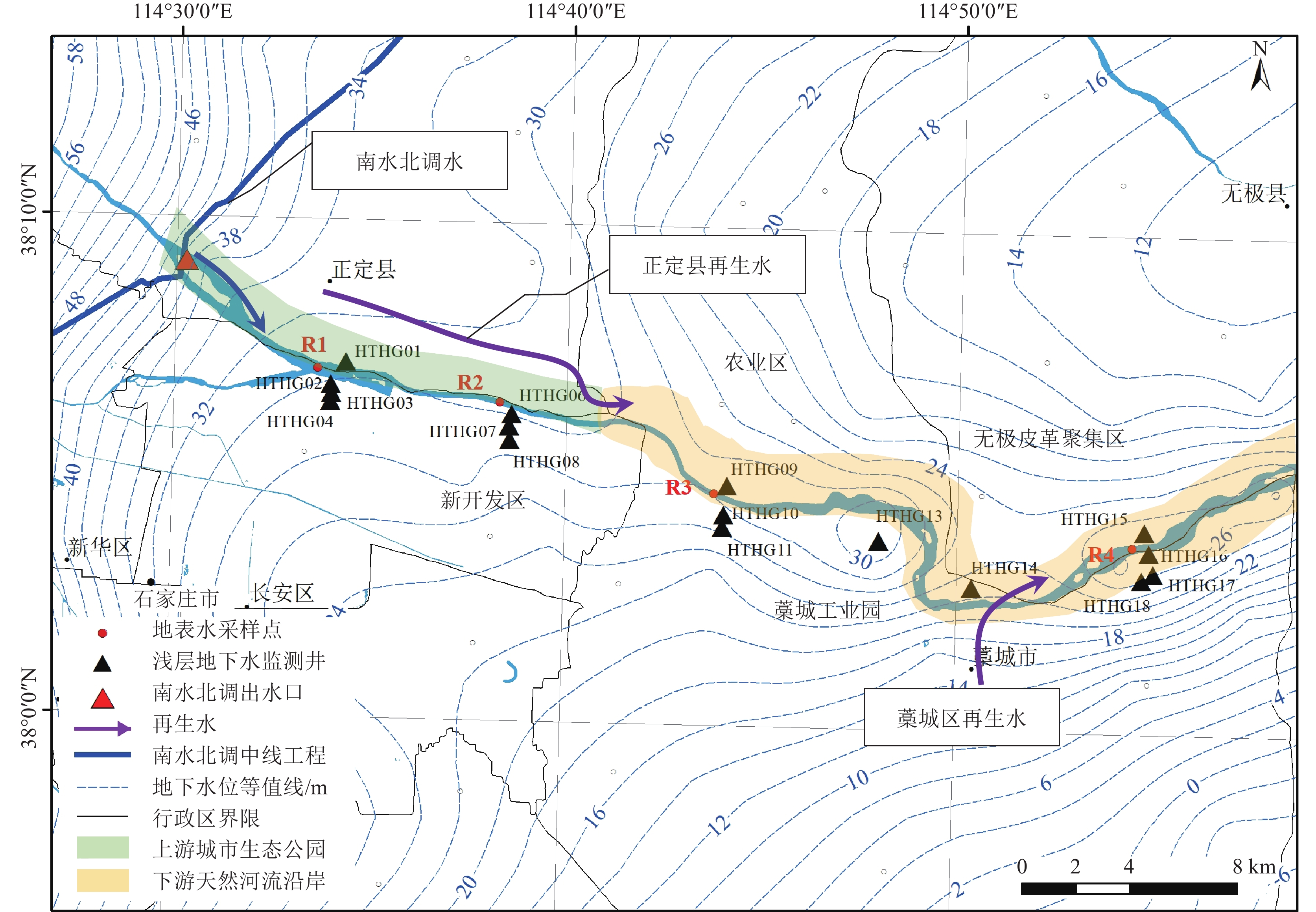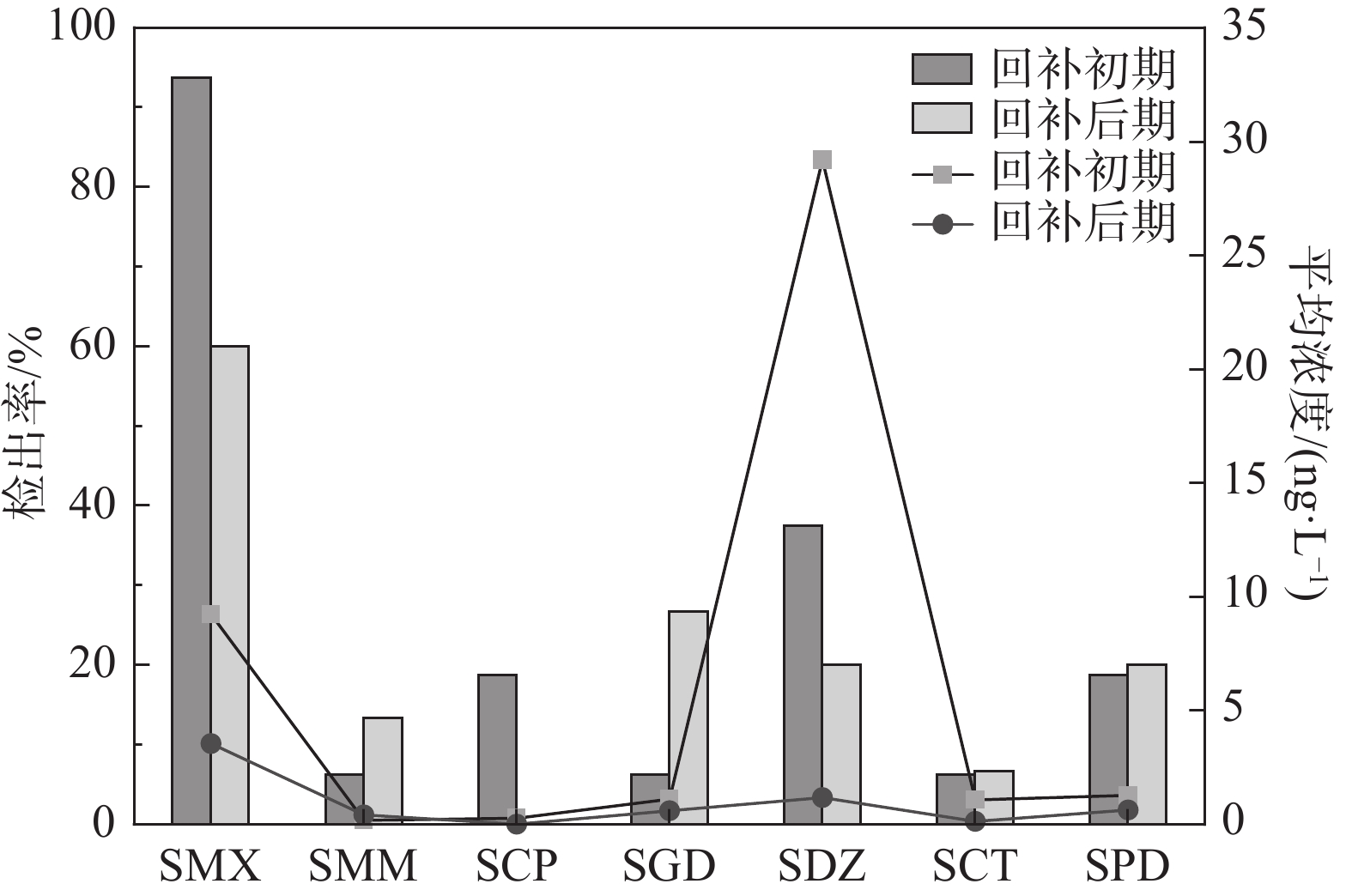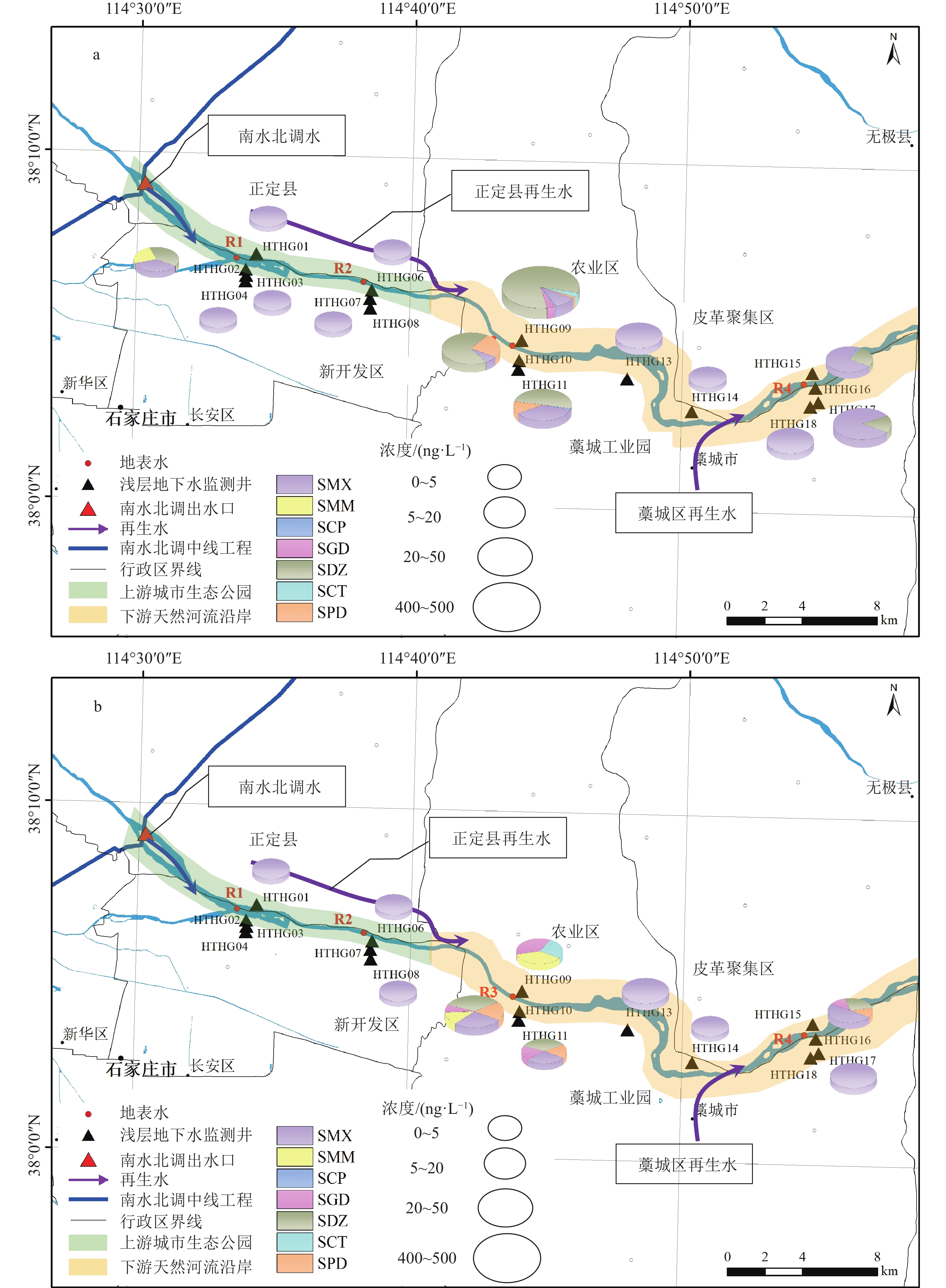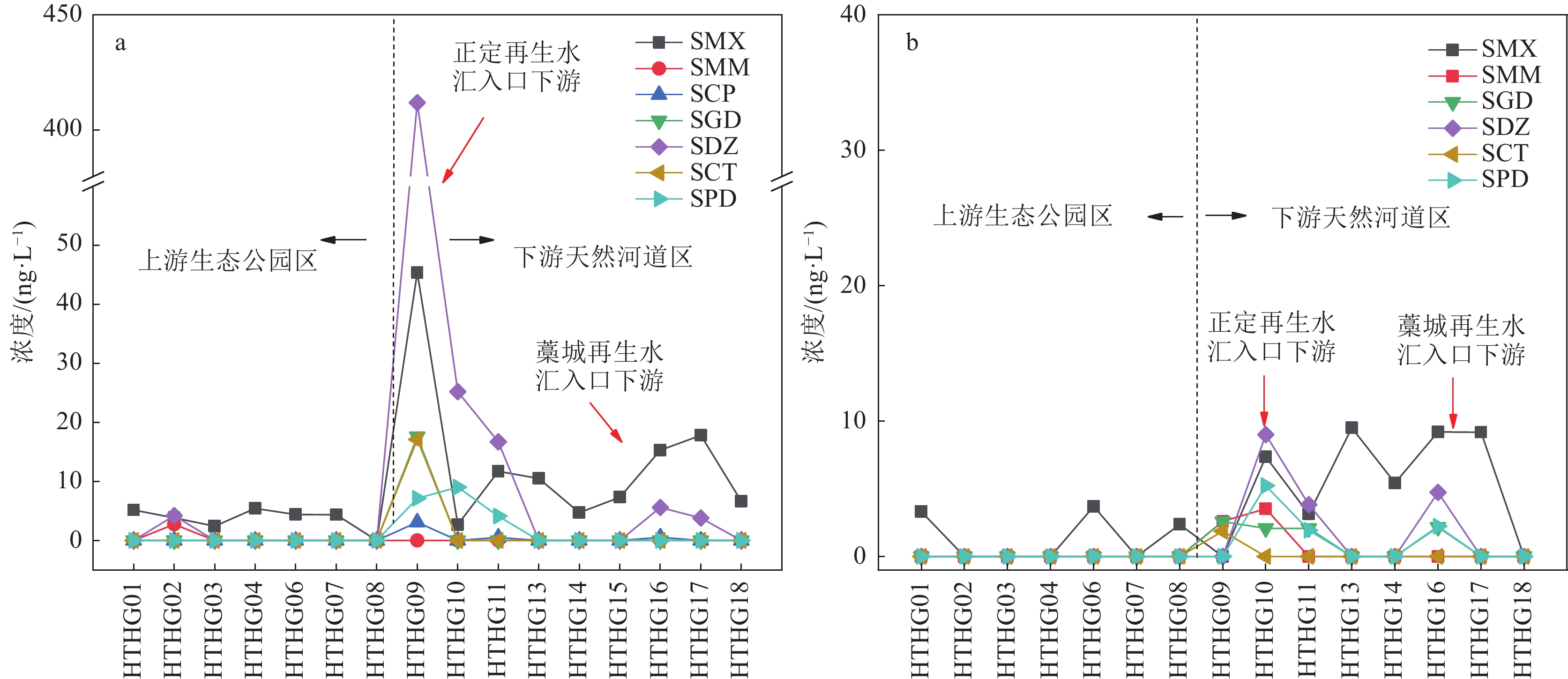Pollution characteristics and risk assessment of sulfonamide antibiotics during shallow groundwater recharge in the Shijiazhuang section of the Hutuo River
-
摘要:
为识别地下水回补过程中磺胺类抗生素(SAs)的污染特征及风险水平,于2020—2021年分2期采集滹沱河补水沿线16口浅层监测井的地下水样品,采用固相萃取-超高效液相色谱串联质谱法,测定分析地下水中20种SAs的浓度水平及分布特征,并利用风险熵值法进行生态及人体健康风险评价。结果表明,地下水中SAs总体污染程度较低,回补初期地下水中共检出7种SAs,按检出率大小依次为磺胺甲恶唑(93.75%)、磺胺嘧啶(37.50%)、磺胺氯哒嗪(18.75%)、磺胺吡啶(18.75%)、磺胺甲氧嘧啶(6.25%)、磺胺脒(6.25%)、磺胺醋酰(6.25%),平均检出浓度最高的为磺胺嘧啶(29 ng/L)和磺胺甲恶唑(9.2 ng/L)。在优质南水北调水回补的混合稀释作用下,地下水中SAs检出率和检出浓度呈明显下降趋势。历史污水处理厂排放及农业畜禽养殖污染是造成局部区域下水中SAs污染的主要原因。地下水中磺胺甲恶唑和磺胺嘧啶在回补初期属于中等生态风险,且磺胺嘧啶对人体健康具有中等风险。回补后期各SAs评价均无明显生态风险和健康风险。
Abstract:In order to identify the pollution characteristics, ecological risk and health risk of sulfa antibiotics (SAs) in groundwater during the Hutuo River recharge process, sixteen shallow groundwater samples were collected twice along the Hutuo River bank from October 2020 to October 2021. The concentrations and distribution characteristics of 20 SAs were determined using solid-phase extraction-ultra high-performance liquid chromatography-tandem mass spectrometry. The results showed that the overall pollution level of SAs in groundwater was relatively low, and only 7 of the 20 SAs were detected in groundwater during the initial recharge period. The concentration of different SAs followed the order of characteristics: sulfametoxydiazine (93.75%), sulfadiazine (37.50%), sulfachlorpyridazine (18.75%), sulfapyridine (18.75%), sulfamonomethoxine (6.25%), sulfaguanidine (6.25%), sulfacetamide (6.25%). The highest average detection concentration SAs were sulfadiazine (29 ng/L) and sulfametoxydiazine (9.2 ng/L). Due to the mixed dilution effect of high-quality South-to-North Water Diversion water, the SAs detection frequency and average detection concentration declined gradually during the groundwater recharge. The historical pollution of sewage treatment plants and agricultural livestock and poultry in this area were the leading causes of SAs pollution in groundwater. The ecological and health risk assessment results indicated that the sulfametoxydiazine and sulfadiazine were medium ecological risks, and the sulfadiazine posed a moderate risk to human health. All SAs showed no obvious ecological risk and health risk in groundwater in the later period of the recharge process.
-
-
表 1 研究区地下水回补过程中SAs检出浓度及检出率
Table 1 Concentrations and detection rate of SAs in groundwater during the recharge process
抗生素 回补初期(2020年10月) 回补后期(2021年10月) 范围/(ng·L−1) 平均值/(ng·L−1) 检出率/% 范围/(ng·L−1) 平均值/(ng·L−1) 检出率/% SMX ND~45.4 9.2 93.75 ND~9.5 3.5 60 STZ BLD BLD BLD BLD BLD BLD SMM ND~2.7 0.2 6.25 ND~3.5 0.4 13.33 SMR BLD BLD BLD BLD BLD BLD SCP ND~3.1 0.3 18.75 BLD BLD BLD MAF BLD BLD BLD BLD BLD BLD SGD ND~17.6 1.1 6.25 ND~2.6 0.6 26.67 SDZ ND~412.0 29 37.5 ND~9.0 1.2 20 SPZ BLD BLD BLD BLD BLD BLD SQX BLD BLD BLD BLD BLD BLD SMP BLD BLD BLD BLD BLD BLD SCT ND~17.1 1.1 6.25 ND~1.9 0.1 6.67 SPD ND~9.0 1.3 18.75 ND~5.2 0.6 20 SSZ BLD BLD BLD BLD BLD BLD SDX BLD BLD BLD BLD BLD BLD SM2 BLD BLD BLD BLD BLD BLD SFM BLD BLD BLD BLD BLD BLD SMZ BLD BLD BLD BLD BLD BLD SMTZ BLD BLD BLD BLD BLD BLD TMP BLD BLD BLD BLD BLD BLD ∑SAs ND~507.0 45.72 93.75 ND~94.6 10.5 62.5 注:BLD表示无数据, ND表示未检出或低于检出限值 表 2 地下水中SAs生态风险评价
Table 2 Ecological risk assessment of SAs in groundwater
SAs 对应最敏感
物种毒性 EC50 AF PNEC 回补初期(RQ) 回补后期(RQ) 参考文献 SMX S. leopoliesis 急性 0.27 1000 270 0.168 0.035 Benoǐt et al., 2004 SMM Lemna minor 急性 1.277 1000 1277 0.002 0.003 Turkdogan et al., 2009 SGD daphnia magna 急性 3.86 1000 3860 0.005 0.001 ECOSAR数据库 SDZ S.capricornutum 急性 2. 2 1000 2200 0.187 0.004 Eguchi et al.,2004 SPD Lemna minor 急性 0.46 1000 4600 0.002 0.001 Bialk-Bielinska et al.,2011 表 3 地下水中典型SAs对人体的健康风险(RQH)
Table 3 RQH values of different populations for SAs antibiotics in groundwater
SAs 2020年 RQH 2021年 RQH 儿童男 儿童女 成人男 成人女 儿童男 儿童女 成人男 成人女 SMX 0.053 0.053 0.060 0.058 0.011 0.011 0.013 0.012 SDZ 0.244 0.238 0.271 0.264 0.005 0.005 0.006 0.006 SPD 0.011 0.010 0.012 0.012 0.006 0.006 0.007 0.007 注:其中BW(kg)取值:儿童男24,儿童女23,成人男66.1,成人女57.8;DWI(L/d)取值:儿童男0.81,儿童女0.76,成人男2.48,成人女2.12。ADI(μg/kg·d)取值:SDZ为20(王浩楠等, 2022);SMX为10(李辉等, 2020);SPD为10(Hanna et al., 2018) -
Bialk−Bielinska A, Stolte S, Jürgen A, et al. 2011. Ecotoxicity evaluation of selected sulfonamides[J]. Chemosphere, 85(6): 928−933. doi: 10.1016/j.chemosphere.2011.06.058
Benoǐt F, Raphael, M, Bernard V, et al. 2004. Environmental risk assessment of six human pharmaceuticals: are the current environmental risk assessment procedures sufficient for the protection of the aquatic environment[J]. Environmental Toxicology and Chemistry, 23(5): 1344−1354. doi: 10.1897/03-246
Barnes K K, Kolpin D W, Furlong E T, et al. 2008. A national reconnaissance of pharmaceuticals and other organic wastewater contaminants in the United States − (I) Groundwater[J]. Science of the Total Environment, 402(2/3): 192−200. doi: 10.1016/j.scitotenv.2008.04.028
Chen J, Xie S. 2018. Overview of sulfonamide biodegradation and the relevant pathways and microorganisms[J]. Science of the Total Environment, 640(1): 1465−1477.
Dong P, Qiu W, He X, et al. 2021. Analysis of physicochemical factors regulating transport behaviors of sulfonamide antibiotics in saturated porous media[J]. Journal of Hydrology, 599: 126381. doi: 10.1016/j.jhydrol.2021.126381
Ding Y, Cui K P, Lv K, et al. 2021. Revealing the hydrological transport and attenuation of 14 antibiotics in a low−flow stream[J]. Science of the Total Environment, 761: 143288. doi: 10.1016/j.scitotenv.2020.143288
Eguchi K, Nagase H, Ozawa M, et al. 2004. Evaluation of antimicrobial agents for veterinary use in the ecotoxicity test using microalgae[J]. Chemosphere, 57(11): 1733−1738. doi: 10.1016/j.chemosphere.2004.07.017
Gustafson D I. 1989. Groundwater ubiquity score: a simple method toxicology and chemistry[J]. Environmental Toxicology and Chemistry, 8(4): 339−357. doi: 10.1002/etc.5620080411
Hanna N, Sun P, Sun Q, et al. 2018. Presence of antibiotic residues in various environmental compartments of Shandong province in eastern China: Its potential for resistance development and ecological and human risk[J]. Environment International, 114: 131−142. doi: 10.1016/j.envint.2018.02.003
Hernando M D, Mezcua M, Fernndez−Alba A, et al. 2006. Environmental risk assessment of pharmaceutical residues in wastewater effluents, surface waters and sediments[ J]. Talanta, 69(2): 334−342.
Huang, F Y, Zou S Z, Deng, D D, et al. 2019. Antibiotics in a typical karst river system in China: Spatiotemporal variation and environmental risks[J]. Science of the Total Environment, 650: 1348−1355. doi: 10.1016/j.scitotenv.2018.09.131
Kosma C I, Lambropoulou D A, Albanis T A. 2014. Investigation of PPCPs in wastewater treatment plants in Greece: Occurrence, removal and environmental risk assessment[J]. Science of the Total Environment, 466/467: 421−438. doi: 10.1016/j.scitotenv.2013.07.044
López−Serna R, Jurado A, Vázquez−Sué E, et al. 2013. Occurrence of 95 Pharmaceuticals and Transformation Products in Urban Groundwaters Underlying the Metropolis of Barcelona, Spain[J]. Environmental Pollution, 174: 305−315. doi: 10.1016/j.envpol.2012.11.022
Ma Y J, Modrzymski J J, Yang Y X, et al. 2021. Redox−dependent biotransformation of sulfonamide antibiotics exceeds sorption and mineralization: Evidence from incubation of sediments from a reclaimed water−affected river[J]. Water Research, 205(15): 117616.
Ma Y, Li M, Wu M, et al. 2015. Occurrences and regional distributions of 20 antibiotics in water bodies during groundwater recharge[J]. Science of the Total Environment, 518/519: 498−506. doi: 10.1016/j.scitotenv.2015.02.100
Martinez J L, Raiber M, Cox M E. 2015. Assessment of groundwater–surface water interaction using long−term hydrochemical data and isotope hydrology: Headwaters of the Condamine River, Southeast Queensland, Australia[J]. Science of the Total Environment, 536: 499−516. doi: 10.1016/j.scitotenv.2015.07.031
Prasannamedha G, Kumar P S. 2020. A review on contamination and removal of sulfamethoxazole from aqueous solution using cleaner techniques: Present and future perspective[J]. Journal of Cleaner Production, 250: 119553. doi: 10.1016/j.jclepro.2019.119553
Turkdogan F I, Yetilmezsoy K. 2009. Appraisal of potential environmental risks associated with human antibiotic consumption in Turkey[J]. Journal of Hazardous Materials, 166(1): 297−308. doi: 10.1016/j.jhazmat.2008.11.012
Wang J, Zhang C, Xiong L, et al. 2022. Changes of antibiotic occurrence and hydrochemistry in groundwater under the influence of the South−to−North Water Diversion (the Hutuo River, China) [J]. Science of The Total Environment, 832: 154779.
Zhang R L, Zhang B Y, Guo Y T, et al. 2023. Replenishment Impacts on Hydrogeochemistry and Water Quality in the Hutuo River Plain[J]. Water, 15: 3326. doi: 10.3390/w15193326
昌盛, 赵兴茹, 刘琰, 等. 2016. 滹沱河冲洪积扇地下水中挥发性有机物的分布特征与健康风险[J]. 环境科学研究, (6): 854−862. 陈李宁. 2021. 滹沱河生态补水不同区段地下水环境变化及影响机制[D]. 中国地质大学(北京)硕士学位论文. 陈卫平, 彭程伟, 杨阳, 等. 2017. 北京市地下水中典型抗生素分布特征与潜在风险[J]. 环境科学, 38(12): 5074−5080. 陈姗, 许凡, 张玮, 等. 2019. 磺胺类抗生素污染现状及其环境行为的研究进展[J]. 环境化学, 38(7): 1557−1569. doi: 10.7524/j.issn.0254-6108.2018091901 陈飞, 丁跃元, 唐世南, 等. 2021. 华北地区河湖生态补水与地下水回补的实践及效果分析[J]. 中国水利, (7): 36−39. doi: 10.3969/j.issn.1000-1123.2021.07.016 陈慧, 剧泽佳, 赵鑫宇, 等. 2022. 石家庄地下水中喹诺酮类抗生素生态风险及其与环境因子的相关性[J]. 环境科学, 43(9): 4556−4565. 戴佳佳, 宋金明, 李学刚, 等. 2023. 中国典型水域磺胺类合成药物的环境生物地球化学特征[J]. 海洋与湖沼, 54(4): 935−950. 龚润强, 赵华珒, 高占啟, 等. 2022. 骆马湖及主要入湖河流表层水体中抗生素的赋存特征及风险评价[J]. 环境科学, 43(3): 1384−1393. 纪浩, 杨依琳, 邢戎光, 等. 2023. 渭河西安段水体中磺胺类抗生素的污染特征及生态风险评价[J]. 环境污染与防治, 45(4): 521−527. 李亚松, 张兆吉, 费宇红, 等. 2014. 河北省滹沱河冲积平原地下水质量及污染特征研究[J]. 地球学报, 35(2): 169−176. doi: 10.3975/cagsb.2014.02.07 李辉, 陈瑀, 封梦娟, 等. 2020. 南京市饮用水源地抗生素污染特征及风险评估[J]. 环境科学学报, (4): 1269−1277. 李佳乐, 王瑶, 董一慧, 等. 2022. 鄱阳湖流域袁河水体典型抗生素分布特征及生态风险评价[J]. 生态毒理学报, 17(4): 563−574. doi: 10.7524/AJE.1673-5897.20211130001 冉泽宇, 贾永锋, 姜永海,等. 2024. 地下水污染源解析方法研究进展[J]. 地质通报, 43(1): 153−162. 生态环境部. 2020. 地下水环境监测技术规范(HJ 164-2020)[EB/OL]. (2020-12-02) [2024-04-23]. https://www.mee.gov.cn/ywgz/fgbz/bz/bzwb/jcffbz/202012/t20201203_811333.shtml. 孙晓林. 2012. 滹沱河冲洪积扇地下水数值模拟及其适宜水位控制研究 [D]. 中国地质大学(北京)硕士学位论文. 田夏, 孟素花, 崔向向, 等. 2021. 滹沱河超采区地下水回补的水化学效应研究[J]. 环境科学研究, 34(3): 629−636. 王新爽. 2017. 不同类型土壤对磺胺甲恶唑的吸附/解吸特性研究[D]. 吉林农业大学硕士学位论文. 王盛, 李文静, 王金凤. 2020. 滹沱河上游径流演变及其影响因素分析[J]. 甘肃农业大学学报, 55(3): 162−169. 王浩楠, 李烨, 傅志强, 等. 2022. 抗生素解离形态对其植物富集及人体暴露的影响[J]. 生态毒理学报, 17(5): 43−53. 席北斗, 李娟, 汪洋, 等. 2019. 京津冀地区地下水污染防治现状、问题及科技发展对策[J]. 环境科学研究, 32(1): 1−9. 余和春. 2018. 地表水回灌过程中典型磺胺类抗生素迁移特性及去除研究[D]. 中国地质大学(北京)硕士学位论文. 赵兴茹, 耿梦娇, 暴志蕾, 等. 2016. 石家庄市滹沱河冲洪积扇地下水中BHT和TEP的污染水平及风险评价[J]. 环境科学研究, 29(9): 1297−1302. 赵涛, 丘锦荣, 蒋成爱, 等. 2017. 水环境中磺胺类抗生素的污染现状与处理技术研究进展[J]. 环境污染与防治, 39(10): 1147−1152.




 下载:
下载:



